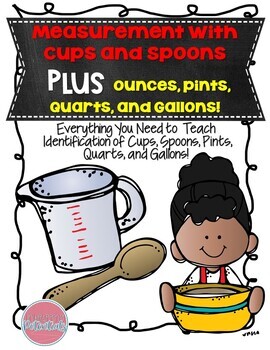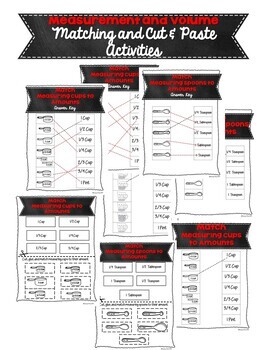Measurement with Cups and Spoons PLUS Ounces, Pints, Quarts, and Gallons!
- PPTX
What educators are saying
Description
This resource contains EVERYTHING you will need to introduce, reinforce, and teach the concepts, terms, and measurement tools needed when introducing Volume and Measurement!
Measurement with Cups and Spoons PLUS Ounces, Pints, Quarts, and Gallons! contains 74 pages chock-full of cut and paste activities, task cards, answer keys and measurement BINGO cards, anchor charts, "I Can" statement charts, vocabulary cards, and matching exercises!
INCLUDED in this resource is a FUN "Reading a Recipe" Activity that includes an interactive "No Bake Granola Bar" Recipe with accompanying differentiated reading comprehension and writing worksheets. This resource is PERFECT to teach in elementary grades and especially designed and differentiated for use with special education students and use in life-skill instruction and activities.
This resource covers the concepts of volume, pint, measurement spoons (Tablespoon, Teaspoon, 1/2 Teaspoon, 1/4 Teaspoon), measurement cups (1 Cup, 1/2 Cup, 1/3 Cup, 1/4 Cup, 2/3 Cup, 3/4 Cup), fluid ounce, pint, quart, and gallon. ALSO included are the concepts of matching amounts and conversions.
Included in this Resource:
- 6 "I Can" Statement Charts
- 1 Editable "I Can" Statement Chart
- 9 Measurement and Volume Anchor Charts
- 22 Measurement and Volume Vocabulary Cards
- 4 Matching Measuring Cups to Amounts Anchor Charts
- Matching Measuring Cups to Amounts Worksheet and Answer Key
- Matching Measuring Spoons to Amounts Worksheet and Answer Key
- Matching Pints, Cups, Ounces, and Gallons to Equivalent Volume Worksheet and
Answer Key
- Cut and Paste Measuring Spoons to Amounts and Answer Key
- Cut and Paste Measuring Cups to Amounts and Answer Key
- Reading a Recipe- No-Bake Granola Recipe with Reading and Writing (Worksheets A
& B)
- Which Holds More or Less? (Cut and Paste Activity) with Answer Key
- What Should You Use to Measure Volume? - Task Card Activity with Answer Key
- Measurement BINGO and calling cards





